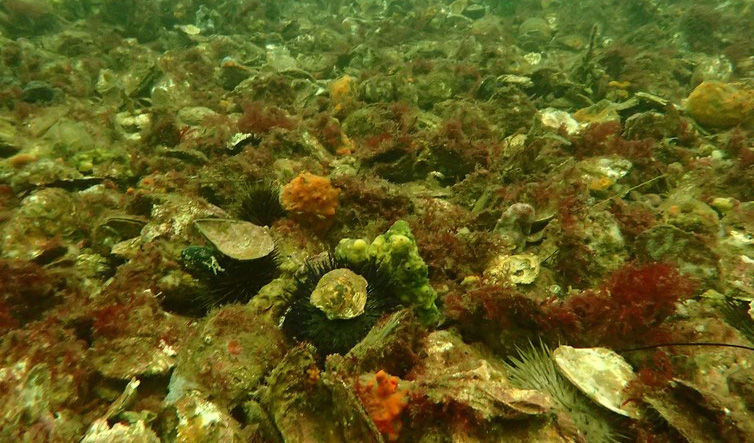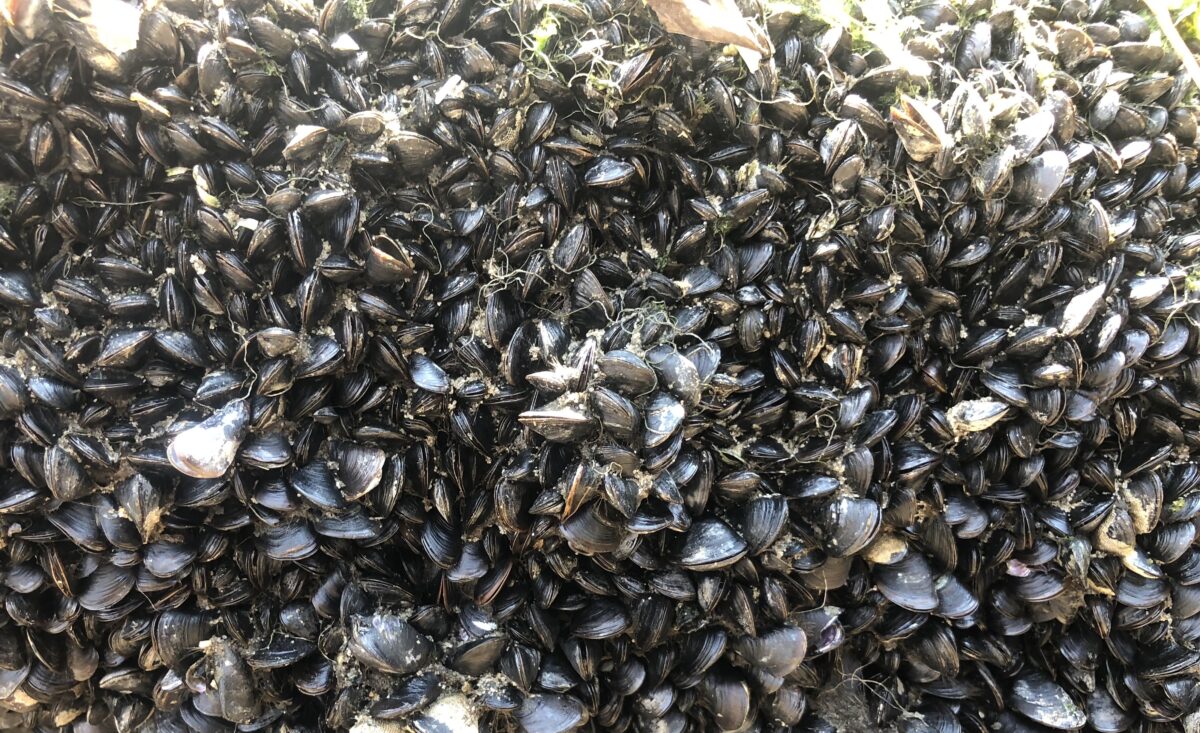Unpack habitat – Shellfish Reefs

As part of the Growing River Stewardship program OzFish, supported by the NSW Government’s Environmental Trust, is unpacking habitat in an eight-part series in which we explore key fish habitat. This week we are looking into shellfish reefs.
What are shellfish reefs?
Shellfish reefs are complex, three-dimensional living structures, which provide food, shelter and protection for a range of marine species. They grow in intertidal and upper subtidal regions of bays, estuaries and nearshore waters. Once upon a time, shellfish reefs were present across temperate, subtropical and tropical regions in Australia.
Reefs are formed by millions of shellfish, predominantly mussels and oysters, but also including pipis and cockles, clustering together. They provide habitat for species by producing a hard substrate surface (the shell clusters) where food can grow, acting as attachment sites for sessile (non-mobile) creatures and shelter for mobile ones. Shellfish are ecosystem engineers that create awesome conditions for fish and marine plants, allowing them to thrive.
Why do fish love shellfish reefs?
Shellfish reefs are critical habitat for many fish species to breed, hide, feed, and for other marine life to colonise. Shellfish reefs are similar to coral reefs, in that they are basically fish production factories. They allow for more biodiversity, creating a smorgasbord for all fish (whether herbivore or carnivore). They also provide invaluable ecosystem services that benefit us and other species, including water filtration and shoreline protection.
For every hectare of oyster reef, each year, the reefs can filter 2.7 billion litres of seawater, remove 225 kilograms of nitrogen and phosphate, produce 375kg more fish and provide new homes for over 100 different marine species.
Since European settlement, Australia has lost 90-99% of our shellfish reef habitat, making them our most critically endangered marine ecosystem. The loss of shellfish reefs has resulted in the loss of social and economic benefits for both people and nature. With the loss of shellfish reefs, we have seen a marked decline in fish numbers and water quality. We are only now realising their value.
How do oysters improve water quality?
Oysters are incredible water filters, and they can filter about 100 litres of water a day (that is about an average-sized bathtub every day), pretty awesome! Mussels also provide valuable water filtration services but not to the same extent. It is essential to keep oysters prevalent in our habitats. We predict that these filtering systems can provide exceptional water clarity, promoting seagrass growth and fish biodiversity around Australia.
Why are shellfish reefs declining?
Shellfish reefs across Australia are in rapid decline with less than 10% remaining. Human impacts such as pollution, sediment runoff from erosion causing poor water quality, overharvesting, and dredging reefs for shells to use as building materials have threatened these reefs since the days of early European settlement.
Fortunately, Australia is one of the leading countries in restoring shellfish reefs. Aussies restore these reefs on the east coast of Australia from Noosa to Melbourne and west from Adelaide to Perth. Restoring them at scale will return great benefits to our fishing communities.
How do shellfish reefs grow?
Oysters begin their life as larvae (microscopic swimmers) and settle down on a solid surface where they will grow for the rest of their lives. In the first year of an oyster’s life, they are not sexually mature. At about 12 months old, they are mature enough to produce sperm. During the second to the third year of the oyster’s life, they change sex to be female and produce eggs. How cool is that? Oysters are generally ready to harvest between the two to the three-year mark of life. Farming oysters provides significant economic value to aquaculture; however, this industry is declining because of water quality issues.
Mussels also start life as larvae and attach themselves to the fish’s gills (which does not harm the fish). They detach once they have grown big enough (this can take up to several months to occur) and fall off the fish’s gills into the water column. They eventually settle on a hard surface and live for up to 60-70 years. Each mussel releases sperm and eggs during the springtime and mass spawn. Mussels are not sexually mature for about 2 years. Fishers love to harvest these guys between June to September each year.
What is OzFish doing to make more shellfish reefs?
OzFish has multiple shellfish reef restoration projects underway and more in the pipeline across Australia.
OzFishers research suitable sites that would be good for restoration (mainly areas where shellfish reefs were once abundant). Our volunteers, community officers, divers, boaties and scientists work together to collate their findings.
There are many ways you can get involved in OzFish shellfish reef restoration, starting with shell recycling. Baby shellfish choose old shells to settle onto and grow, so it is essential to return shells to the water, that way, they can become the foundations of future shellfish reefs. OzFish collects shells from restaurants and wholesalers weekly, returning them to our shell recycling centre, putting them through a washing and sun drying process for 4+ months before they are ready to turn into shellfish reef blocks.
You can also be part of creating and deploying the OzFish shellfish reef blocks. Triangular Robust Oyster Baskets (ROBs) are filled with the cleaned shell and deployed to re-establish lost shellfish reefs. They are also placed onto a special oyster lease to attract and grow baby shellfish (ensuring greater genetic diversity) before being deployed to their final reef location. This job means boat trips to the oyster lease are part of your OzFish day!
OzFish actively monitors the areas for several years to ensure that they are growing (the reef dimensions and mortalities) and that no diseases enter the habitat. We also monitor fish and invertebrate numbers, and the overall water quality. OzFish fishers and scientists work together on this important monitoring.
Become an OzFish member and help out with reef restoration projects. We have multiple reef projects across Australia with something for everyone to do.
Fishing where oysters grow
Fish like jewfish love shellfish reefs, and you will catch them where you find oysters growing on rock walls or in remnant reefs. Jewfishing with an unweighted live bait or a lure is excellent for fishing around shellfish reef, it is a technique that works, and it also limits any damage to the reef. Be sure not to anchor; anchors can be noisy and scare fish. Drift fish in the area or use an electric motor to keep you in place.
Author – Demara Gates
Demara is currently studying at Southern Cross University completing her Marine Science and Land Management degree. She has been privileged to be accepted as an intern with OzFish. She enjoys fishing, snorkelling and getting out on her boat with family and friends around NSW Northern Rivers.









